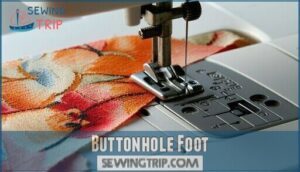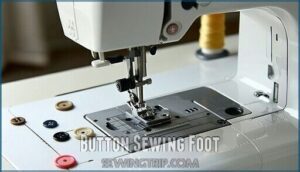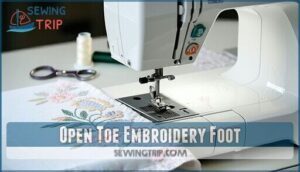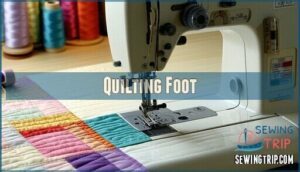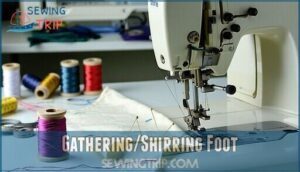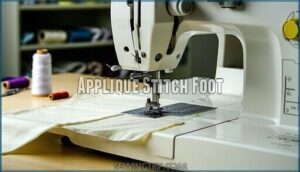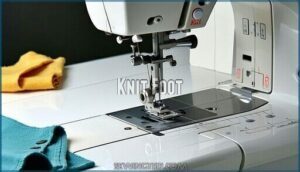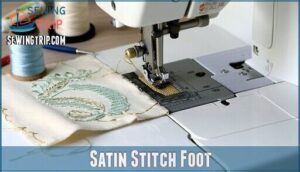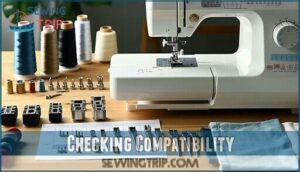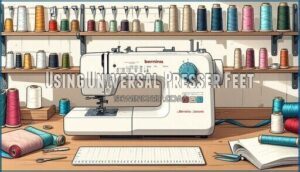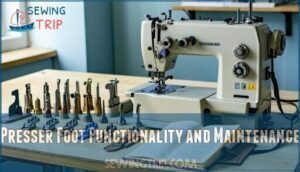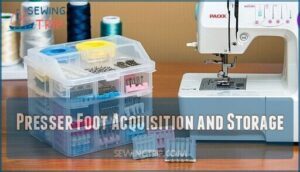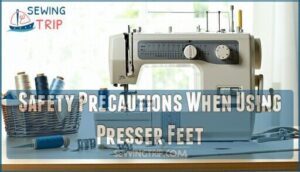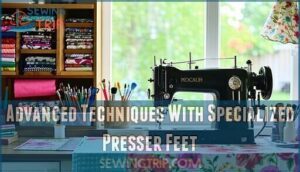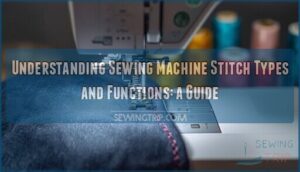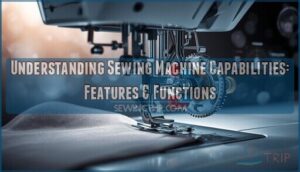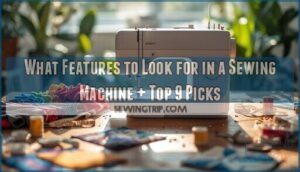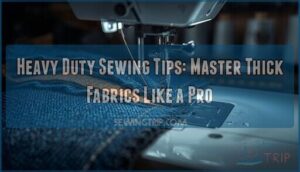This site is supported by our readers. We may earn a commission, at no cost to you, if you purchase through links.
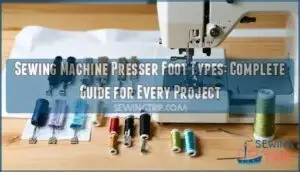 You’ll find dozens of sewing machine presser foot types designed for specific tasks.
You’ll find dozens of sewing machine presser foot types designed for specific tasks.
The most common ones include the zigzag foot for general sewing, straight stitch foot for precise seams, and zipper foot for installing zippers and piping.
Specialized feet like buttonhole, walking, and blind hem feet tackle advanced techniques.
Quilters love the quilting foot, while embroiderers reach for open toe feet.
Button sewing, gathering, and overcast feet handle their namesake tasks perfectly.
Each foot’s unique design guides fabric differently, creating professional results that’d be impossible with just your standard foot.
Understanding which foot works best for each project transforms your sewing from good to exceptional.
Table Of Contents
- Key Takeaways
- Types of Presser Feet Attachments
- Essential Presser Feet for General Sewing
- Specialized Presser Feet for Advanced Techniques
- Less Common but Useful Presser Feet
- Choosing The Right Presser Feet for Your Machine
- Presser Foot Functionality and Maintenance
- Presser Foot Acquisition and Storage
- Safety Precautions When Using Presser Feet
- Advanced Techniques With Specialized Presser Feet
- Troubleshooting Common Presser Foot Issues
- Frequently Asked Questions (FAQs)
- Conclusion
Key Takeaways
- You’ll need to verify your machine’s shank type before buying presser feet – most home machines use a low shank (½ inch), while industrial machines use a high shank (¾ inch), and compatibility isn’t universal despite "universal" marketing claims.
- Essential feet, such as straight stitch, zigzag, zipper, and buttonhole feet, handle 80% of your projects – these foundational tools deliver professional results for basic sewing tasks and should be your first investment after your machine’s standard foot.
- Specialized feet transform advanced techniques from frustrating to effortless – walking feet conquer thick layers, embroidery feet provide clear visibility for decorative work, and gathering feet create consistent pleats automatically.
- Proper maintenance and storage extend the lifespan of your feet while preventing costly machine damage – clean your feet regularly with a soft brush, store them in labeled compartments, and always check alignment before sewing to avoid needle breakage.
Types of Presser Feet Attachments
Understanding how presser feet attach to your sewing machine is essential for expanding your stitching capabilities.
Most modern machines use either snap-on or screw-on systems, with compatibility depending on whether you have a low shank or high shank machine, which is crucial for compatibility.
Snap-on Presser Feet
Snap-on presser feet are the workhorses of modern sewing, clicking into place without tools or fuss. These game-changers transform your machine’s capabilities instantly, making foot swaps effortless during multi-technique projects.
Here are five key benefits of snap on feet:
- Tool-free installation – No screwdrivers needed for quick changes
- Universal compatibility – Most standard presser foot holders accept them
- Secure attachment – Positive click confirms proper seating
- Easy removal – Simple lever press releases the foot
- Cost-effective – Affordable way to expand sewing machine feet types
Screw-on Presser Feet
Screw-on presser feet offer rock-solid stability that snap-on versions can’t match, making them perfect for demanding projects.
- Secure attachment prevents foot movement during heavy-duty stitching
- Enhanced precision for professional results on challenging fabrics
- Shank conversion compatibility allows use across different machine types
These presser foot accessories require screw removal but deliver superior foot alignment and control.
Low Shank and High Shank Varieties
Beyond screw-on options, your sewing machine’s shank height reveals which presser foot types you can use.
Low shank machines measure ½ inch from needle to foot holder, while high shank measures ¾ inch. Most home machines are low shank, but checking prevents costly compatibility mistakes.
Understanding the differences in shank height types is essential for selecting the right presser feet for your projects.
| Feature | Low Shank | High Shank |
|---|---|---|
| Height | ½ inch (12.7mm) | ¾ inch (19mm) |
| Common Machines | Brother, Singer, Janome | Industrial, some Pfaff |
| Foot Availability | Widest selection | Limited options |
| Conversion Options | Adapters available | Shank conversion kits |
| Price Range | $5-30 per foot | $15-50 per foot |
Essential Presser Feet for General Sewing
When you’re starting your sewing journey, these five essential presser feet will handle about 80% of your everyday projects.
Each foot serves a specific purpose that transforms your basic sewing machine into a versatile tool for professional-looking results.
Straight Stitch Presser Foot
Your straight stitch foot is the workhorse that makes every seam count.
This standard foot delivers exceptional sewing precision through its narrow needle opening and perfect fabric guidance.
- Creates razor-sharp edge stitching along hems and seams
- Maintains consistent foot alignment for professional results
- Provides superior stitch quality on lightweight to medium fabrics
- Functions as your reliable seam marker foot for accurate measurements
The straight stitch foot is often used with a sewing machine foot to achieve professional-looking results.
Zigzag Presser Foot
Your zigzag foot opens up endless creative possibilities with its ability to handle varying stitch widths and decorative patterns.
This essential sewing machine presser foot delivers superior fabric guidance and sewing precision across stretch materials, appliqué work, and finishing raw edges.
Its versatile foot adjustment capabilities guarantee consistent stitch quality, making it indispensable among presser foot types for both functional and decorative zigzag stitches.
Zipper/Piping Foot
Move beyond the zigzag foot to master the zipper/piping foot – your precision tool for professional seam work.
This narrow, adjustable sewing machine presser foot lets you stitch incredibly close to zipper teeth and piping cord edges.
Perfect for zipper installation and piping techniques, it features:
- Adjustable needle positioning for left or right side stitching
- Narrow design that hugs bulky edges without catching
- Grooved bottom for smooth fabric guidance over raised elements
- Universal compatibility with most sewing machine feet types
Simply adjust the foot position, align your fabric, and watch those tricky seams become effortless.
Invisible Zipper Foot
If you’ve ever wrestled with zipper installation, the invisible zipper foot will feel like your new best friend.
This foot’s grooves guide zipper teeth perfectly, letting your needle get close for a flawless, hidden finish. Paired with good foot alignment and steady fabric guidance, you’ll discover sewing techniques that rival any store-bought garment.
| Foot Type | Best For | Pro Tip |
|---|---|---|
| Invisible Zipper | Seamless zippers | Press zipper coils flat |
| Quarter Inch | Precise seams | Use for quilt piecing |
| Edge Stitch | Topstitch accuracy | Align guide with seam |
The table provides a summary of different foot types, including the Invisible Zipper, Quarter Inch, and Edge Stitch feet, along with their best uses and pro tips.
Hemmer Foot
After mastering invisible zippers, you’ll love the hemmer foot for creating picture-perfect edges.
This attachment transforms hemming techniques into a breeze, handling everything from delicate silks to sturdy cottons.
- Rolled hemming foot creates narrow, professional hems automatically
- Blind hem foot produces invisible hems on garments and curtains
- Adjustable blind hem foot offers customizable stitch placement for precise fabric handling
- Proper foot maintenance guarantees consistent edge finishing and long-lasting sewing hems
Specialized Presser Feet for Advanced Techniques
Once you’ve mastered the basics, specialized presser feet reveal professional techniques that’ll transform your sewing projects from amateur to expert-level work.
These advanced tools handle everything from perfect buttonholes to intricate embroidery, giving you the precision and control needed for complex techniques that would be nearly impossible with a standard foot.
Buttonhole Foot
Your buttonhole foot creates perfect openings for buttons with professional precision. This specialized attachment guides fabric while your machine stitches consistent, reinforced holes.
To achieve superior results, understanding buttonhole settings is vital for various sewing projects.
Proper foot alignment and fabric choice guarantee superior stitch quality every time you sew.
Button Sewing Foot
Through its unique design, the button sewing foot transforms tedious hand-sewing into quick machine work.
This specialized presser foot attachment grips buttons securely while your sewing machine creates consistent stitches.
Here’s what makes this foot essential:
- Button Alignment stays perfect with built-in guides
- Sewing Speed increases dramatically over hand-sewing methods
- Stitch Quality remains uniform across different fabric thickness levels.
The foot adjustment mechanism accommodates various button sizes effortlessly.
Open Toe Embroidery Foot
The open toe embroidery foot transforms your free-motion designs with crystal-clear visibility.
This transparent presser foot eliminates guesswork, letting you watch your needle create intricate patterns with precision.
Its shortened design and underside groove accommodate dense decorative stitches while preventing fabric puckering.
Perfect for appliqué work, decorative stitching, and detailed embroidery projects requiring exact stitch control.
The foot is ideal for use with Singer sewing machines to achieve professional results.
Quilting Foot
The quilting foot transforms your sewing machine into a precision instrument for multi-layer fabric work.
The quilting foot delivers professional-looking results through its extended length and specialized markings that guide consistent seam allowances.
Here’s what makes this presser foot essential for quilting techniques:
- Extended length provides better fabric control during complex quilting maneuvers
- Precise markings guarantee accurate seam allowances for perfect quilt blocks
- Smooth gliding action prevents fabric bunching on thick batting layers
- Corner pivoting guides help you navigate sharp turns with stitch control
The key features of the quilting foot work together to make it an indispensable tool for quilting projects, ensuring that each quilt block is perfectly stitched and aligned.
Gathering/Shirring Foot
Anyone can master fabric control with the right gathering foot.
This versatile presser foot attachment transforms plain fabric into textured masterpieces through advanced gathering techniques and shirring effects.
- Automatic fabric gathering – Creates consistent pleats without manual basting
- Adjustable fullness control – Regulates gather density for different textile manipulation needs
- Elastic cord threading – Enables professional shirring effects with sewing elastic integration
- Multiple fabric compatibility – Works with lightweight to medium-weight materials seamlessly
Applique Stitch Foot
The applique stitch foot transforms your sewing machine into a precision tool for decorative work.
This specialized foot features a clear or open toe design that gives you perfect visibility while stitching around curves and intricate shapes.
Applique Tips include choosing the right Fabric Choice – cotton works best for beginners.
The foot’s Stitch Control allows precise Sewing Accuracy when attaching fabric pieces, making it superior to a standard satin stitch foot for detailed work.
Darning Foot
The darning foot transforms fabric repair into an art form, letting you freely maneuver damaged areas under the needle.
This presser foot drops your feed dogs out of action, giving you complete control for free motion mending and creative stitching.
- Free motion repairs – Move fabric in any direction to cover holes and tears
- Quilting versatility – Perfect for stippling and decorative stitching patterns
- Easy installation – Snaps onto most sewing machine feet systems quickly
- Fabric mending magic – Restores worn clothing, linens, and quilts beautifully
- Foot maintenance tip – Clean regularly to prevent thread buildup affecting movement
Knit Foot
Most experienced sewers know that knit foot transforms your relationship with stretchy fabrics.
This specialized attachment prevents fabric stretch during stitching, maintaining your knit fabric’s natural elasticity while creating professional knit seams.
| Feature | Benefit | Best For |
|---|---|---|
| Wider sole plate | Even pressure distribution | Jersey, cotton knits |
| Lower foot pressure | Prevents fabric distortion | Delicate stretch fabrics |
| Special feed mechanism | Maintains fabric stretch | Sewing knits smoothly |
When sewing machine presser foot types for stretch materials, the knit foot stands out among sewing feet types.
It’s designed specifically for knit stitch applications, making those tricky t-shirt hems and athletic wear repairs manageable.
Your machine presser feet collection isn’t complete without this essential tool for sewing presser feet versatility.
Satin Stitch Foot
Dense decorative stitching becomes effortless with your satin stitch foot. Its grooved bottom prevents thread buildup while maintaining consistent stitch quality across fabric weights.
Perfect for appliqué edges and embellishments, this sewing machine presser foot glides smoothly through decorative stitching projects.
Proper foot care and following basic sewing tips guarantee your satinstitch foot delivers professional results every time.
Stitch Guide Foot
Precision transforms your sewing from good to exceptional.
The stitch guide foot delivers that accuracy through adjustable guides and clear markings.
You’ll achieve perfect seam allowances and ruler-straight topstitching every time.
This foot’s fabric guidance system keeps your needle exactly where you want it, giving you thread control that makes professional results feel effortless.
The combination of these features results in a sewing experience that is both exceptional and precise, allowing for a high level of craftsmanship in every stitch.
Less Common but Useful Presser Feet
You’ll find these lesser-known presser feet solve specific sewing challenges that standard feet can’t handle effectively. They’re the secret weapons that can transform frustrating techniques into smooth, professional results.
Overcast Stitch Foot
Your overcast stitch foot creates professional-looking fabric edges without expensive serger equipment. This specialized attachment guides material while forming neat overcast stitches that prevent fraying on knits and wovens. The overedge foot maintains consistent stitch quality through its unique design that holds fabric edges perfectly aligned.
- Edge sewing becomes effortless with built-in fabric guides that guarantee straight, even sewing finishes
- Works with zigzag and overlock stitches to seal raw edges on everything from delicate silks to heavy denim
- Saves money by eliminating the need for a separate serger while delivering professional results
The proper use of an overcast stitch foot is often found in sewing machine accessories that can enhance overall sewing performance.
Edge Joining Foot
Two fabrics become one with the edge joining foot, your go-to tool for flawless edge seaming and fabric binding.
This edge stitch foot guides fabric edges together, creating professional seam finishing that’s perfect for delicate materials.
Whether you’re mastering hemming techniques or need precise edge stitching, this edgestitch foot delivers clean results every time.
Blind Stitch Foot
A masterpiece of invisible hemming, the blind stitch foot creates professional hems that seem untouched by machine.
You’ll guide fabric through its unique channel while the needle catches just a thread or two from the front fabric.
This blind hem foot delivers stitch quality that rivals expensive tailoring.
With proper foot care and fabric guide positioning, you’ll master sewing tips that transform ordinary hems into works of art.
Adjustable Zipper Foot
When you’re working with challenging zipper installations, the adjustable zipper foot becomes your secret weapon.
Unlike fixed zipper feet, this adjustable presser foot slides left or right, letting you position it perfectly for zipper alignment and precise foot adjustment.
You’ll glide effortlessly along zipper teeth with superior fabric guidance, making sewing zippers foolproof every time.
Walking Foot
Your walking foot conquers what other sewing machine presser foot types can’t handle. This specialized foot control types attachment features feed dogs that move with your fabric, ensuring perfect layer management and even stitching.
- Fabric feeding stays consistent through multiple layers
- Thick sewing becomes manageable with heavy materials
- Quilting tips experts swear by for matching seams
- Prevents puckering on stretchy or slippery fabrics
Choosing The Right Presser Feet for Your Machine
Selecting the right presser feet for your sewing machine isn’t as complicated as it might seem—you just need to know your machine’s compatibility requirements first.
Once you understand whether your machine uses snap-on or screw-on feet and identify your shank type, you’ll be able to choose from thousands of options that’ll transform your sewing projects.
Checking Compatibility
Before diving headfirst into presser foot shopping, check your machine’s manual and model number against compatibility charts.
Machine fit isn’t guaranteed with universal feet – major brands like Janome and Brother typically accept standard options, while European manufacturers like Bernina often need specific adapters.
Verify shank sizes, mounting mechanisms, and needle alignment to avoid costly mistakes and guarantee proper sewing machine presser foot types function perfectly.
Understanding Shank Types
Your sewing machine’s shank type determines which feet you can use – it’s that simple.
Low shank machines measure about 3/4 inch from needle to attachment point, while high shank machines sit around 1-1/4 inches.
Most home machines use low shank, but check your manual to be sure before buying new feet.
Understanding the correct presser foot functions is essential for superior sewing performance.
Using Universal Presser Feet
Universal presser feet offer incredible flexibility across different sewing machine brands.
While they’re marketed as "universal," compatibility isn’t guaranteed—your machine’s shank type and attachment mechanism matter.
Test before committing to larger purchases. Look for reputable manufacturers like Bernina or Janome that offer reliable universal attachments.
These versatile sewing machine feet can handle basic tasks wonderfully, though specialized presser foot types often deliver superior results for specific techniques.
Presser Foot Functionality and Maintenance
Understanding how your presser feet work and keeping them clean guarantees smooth sewing and extends their lifespan.
They are the workhorses of your machine – they deserve proper care to keep performing their best.
How Presser Feet Work
Now that you’ve found compatible feet for your machine, understanding presser foot function helps you maximize their potential.
Presser foot mechanics work through precise foot alignment above feed dogs, creating controlled pressure that guides fabric smoothly beneath the needle.
This fabric guidance system guarantees consistent stitch formation by maintaining steady material flow.
Different presser foot types optimize specific techniques—your sewing machine presser foot acts like a skilled dance partner, leading fabric through each stitch with perfect timing.
Sewing machine feet compatibility matters because proper sewing machine feet functions depend on correct pressure distribution.
Master these sewing optimization principles, and you’ll transform ordinary seams into professional results every time.
Raising and Lowering Presser Feet
Once you grasp how presser feet work, mastering Foot Lifting becomes your gateway to sewing success. The presser foot lever gives you complete Lever Control over fabric positioning and Presser Alignment.
- Raise the sewing machine presser foot completely before inserting fabric
- Lower gently to achieve proper Foot Adjustment without crushing delicate materials
- Use Foot Release technique between seams for smooth fabric repositioning
Perfect presser foot function depends on consistent lever movements. Your sewing machine feet need proper height adjustment for different fabric weights – thick denim requires more clearance than silk. Practice this fundamental skill until standard presser feet positioning becomes second nature.
Cleaning and Storing Presser Feet
After mastering presser foot operation, proper maintenance keeps your collection performing like new.
Clean each foot with a soft brush or damp cloth, removing lint and debris from grooves and crevices.
Pro tip: Store feet in labeled compartments or magnetic strips to prevent damage and maintain easy access for your next project.
Presser Foot Acquisition and Storage
You’ll find presser feet through online retailers, local sewing shops, and manufacturer websites, with multi-packs offering the best value for building your collection.
Smart storage solutions keep your growing foot collection organized and accessible, turning what could be a jumbled mess into an efficient system that saves time during projects.
Buying Presser Feet Online
Shopping for sewing machine presser foot types online opens up a world of possibilities beyond your local store’s limited selection.
Start with trusted retailers like Amazon, eBay, and specialized sewing websites that offer detailed sewing machine feet charts and guides.
Check seller ratings and online reviews carefully – they’re your best friend for avoiding duds.
Compare shipping costs between vendors, as lightweight feet can vary dramatically in delivery fees.
Always verify foot compatibility with your machine model before purchasing.
Smart price comparison across multiple sites can save you serious cash, especially when hunting for multipacks that offer better value than individual purchases.
Purchasing Multi-Packs for Cost Savings
Multi-packs deliver serious cost savings for sewing machine feet accessories.
You’ll spend $70-$100 for 20-32 presser feet versus $10-$40 each individually.
That’s 60-80% savings on foot varieties you actually need.
Generic kits from online shopping platforms offer quality budget options.
Compare contents carefully—some multipacks include specialty feet worth the investment, while others pack basic duplicates.
When selecting a multipack, consider the sewing feet kits available to make certain you get the best value.
Storing Presser Feet for Easy Access
Smart organization transforms your sewing experience.
Keep your presser foot accessories within arm’s reach with these proven strategies:
- Magnetic strips mounted on craft walls hold metal feet securely
- Clear accessory cases with labeled compartments sort different foot types
- Expandable presser boxes store entire sewing kits in drawers
Create a simple numbering system matching your machine’s guide for instant identification.
Effective storage solutions can greatly improve your sewing workflow.
Safety Precautions When Using Presser Feet
When you’re working with presser feet, safety should always be your top priority to avoid costly repairs and frustrating delays in your sewing projects.
You’ll want to take specific precautions to prevent needle breakage and protect your machine from damage that could sideline your creativity for weeks.
Avoiding Needle Breakage
Now that you’ve got your presser feet sorted and stored properly, let’s talk about keeping those needles in one piece. Nothing kills your sewing momentum like a broken needle mid-project.
Proper Threading and Needle Selection prevent most breakage issues. Match your needle type to your Fabric Choice – ballpoint needles for knits, sharp needles for wovens. Tension Control matters too; overly tight tension puts unnecessary stress on needles.
Here’s your Breakage Prevention checklist:
- Verify sewing machine presser foot types match your stitch selection before starting
- Replace bent or dull needles immediately – they’re accident magnets
- Go slow through thick seams and multiple fabric layers
Sewing machine feet maintenance includes checking that your presser foot sits level. Misaligned feet can cause needles to hit metal parts. Regular sewing machine feet care and presser foot care keeps everything running smoothly, preventing costly sewing machine needle breakage.
Preventing Machine Damage
Your sewing machine deserves respect, not rough handling.
Always secure presser feet properly to prevent foot alignment issues and needle strikes.
Never force stubborn attachments or ignore unusual sounds.
Keep your workspace clean, check machine safety settings, and follow manufacturer guidelines.
Proper sewing maintenance and presser foot care protect your investment while ensuring smooth operation for years.
Advanced Techniques With Specialized Presser Feet
You’ll transform from basic stitching to professional-quality work once you master these specialized feet designed for specific techniques.
Each foot opens up new creative possibilities that’ll make your projects look like they came from an expensive boutique, with professional-quality work being the ultimate goal.
Creating Buttonholes With a Buttonhole Foot
Creating perfect buttonholes starts with your buttonhole foot alignment.
This specialized attachment guides fabric precisely while your machine stitches consistent openings.
Test stitch quality on scrap fabric choice first—matching thread weight to material thickness prevents puckering.
Mark placement carefully, then let the foot’s measurements handle sizing automatically.
These sewing hacks transform tricky buttonhole tips into professional results every time.
Sewing Buttons With a Button Sewing Foot
Take control of button placement with your button foot – this specialized presser foot transforms frustrating hand-sewing into precise machine work.
Lower your feed dogs, adjust sewing speed to medium, and let the foot secure your button while zigzag stitches lock it tight.
Perfect fabric tension and proper thread choice guarantee professional results every time.
Free-Motion Embroidery With an Open Toe Foot
Your machine’s open toe foot releases creative freedom for stunning free-motion embroidery.
This specialized foot provides unobstructed needle visibility, letting you guide fabric smoothly while creating intricate designs.
Master these essential techniques:
- Foot Control – Lower feed dogs and maintain steady presser foot pressure
- Thread Selection – Choose high-quality embroidery thread for best results
- Fabric Choice – Use stabilizer backing for professional-looking stitches
- Stitch Variations – Experiment with different speeds and directions
- Embroidery Tips – Practice consistent hand movements before tackling complex patterns
This free motion foot transforms your sewing machine into an artistic tool, perfect for appliqué work and decorative stitching.
Troubleshooting Common Presser Foot Issues
Even the most experienced sewers encounter presser foot problems that can turn a simple project into a frustrating puzzle.
You’ll face compatibility issues and alignment troubles at some point, but knowing how to troubleshoot these common problems will keep your sewing machine running smoothly.
Resolving Compatibility Problems
When your foot compatibility hits a snag, check your machine’s shank types first—low or high determines everything.
Most home machines use low-shank feet, while industrials need high-shank versions.
Machine adapters can bridge the gap between different systems.
Shank conversion adapters let you use universal feet on Bernina or slant-shank machines.
Always verify foot alignment before sewing—mismatched feet cause skipped stitches and needle breaks.
Fixing Presser Foot Alignment Issues
Foot Alignment mishaps can derail your project faster than you’d think. Start by checking if your presser foot sits parallel to the needle plate—misalignment here causes sewing errors and uneven stitches.
Loosen the presser adjustment screw and realign carefully. Machine calibration might need professional attention if problems persist.
Proper fabric guidance depends on correct sewing machine presser foot types positioning for flawless results. Understanding presser foot issues is essential for identifying and resolving common sewing machine problems.
Frequently Asked Questions (FAQs)
Can you use any presser foot on any sewing machine?
Unfortunately, you can’t use any presser foot on every machine – compatibility depends on your machine’s shank type.
Most machines use low shank, high shank, or slant shank systems, so you’ll need matching feet for proper fit.
What are the different types of sewing machine presser feet?
You’ll find dozens of presser foot types designed for specific tasks.
Common ones include all-purpose, zipper, buttonhole, and walking feet.
Specialized options cover embroidery, quilting, overcasting, and leather work for different techniques.
What are the different types of sewing machine feet?
Various sewing machine feet reveal specialized techniques you’ll master with practice. You’ll find all-purpose, zipper, buttonhole, walking, overcast, embroidery, pintuck, ruffler, beading, fringe, teflon, gathering, quilting, and darning feet available.
What is a presser foot in a sewing machine?
Think you’ve mastered your sewing machine until you encounter that mysterious little contraption clamped beneath the needle?
That’s your presser foot—your fabric’s best friend that holds, guides, and feeds material through stitches seamlessly, acting as your fabric’s best friend.
What are the different types of presser feet?
You’ll encounter several essential types: all-purpose feet for basic stitching, zipper feet for closures, buttonhole feet for openings, walking feet for thick layers, and specialty feet like hemming, embroidery, and leather feet.
How do I choose the right presser feet for my sewing machine?
Like selecting the perfect thread for your masterpiece, choosing presser feet requires matching foot function to your project’s needs.
Check your machine’s shank compatibility, consider your sewing goals, and start with essential feet like zipper, buttonhole, and walking feet.
High-end electric bikes between $3,500 and $5,000 deliver premium performance with advanced motors, sophisticated battery systems, and professional-grade components.
You’ll find top-tier brands offering cutting-edge features like integrated displays, hydraulic disc brakes, and carbon fiber frames that justify the investment.
What are presser feet?
Presser feet are detachable sewing machine components that hold your fabric steady while guiding it smoothly through the machine.
You’ll swap different feet to achieve specific techniques like hemming, zipping, or decorative stitching with professional results.
What are the types of presser feet?
Numerous versatile varieties await your sewing adventures! You’ll find essential types like all-purpose, zipper, and buttonhole feet for basic tasks.
Specialized options include walking feet for thick fabrics, embroidery feet for decorative stitching, and Teflon feet for challenging materials like leather and vinyl.
What is the most commonly used presser foot?
The all-purpose foot (also called straight stitch foot) reigns supreme in your sewing arsenal.
You’ll reach for this versatile workhorse on nearly every project since it handles basic seaming, edge stitching, and most standard tasks with ease.
What is the plastic presser foot for?
Think of plastic as your safety net against fabric rebellion.
You’ll use the plastic presser foot (also called non-stick or Teflon foot) when sewing sticky synthetic fabrics, vinyl, leather, or PVC materials that would otherwise grip and stick to metal feet, which can be considered a non-stick solution.
Conclusion
Mastering the countless sewing machine presser foot types available transforms ordinary projects into professional masterpieces, while ignoring them leaves you struggling with basic techniques.
You’ve discovered how each specialized foot serves its unique purpose, from precise straight stitching to intricate embroidery work.
Whether you’re installing zippers, creating buttonholes, or quilting elaborate patterns, the right presser foot makes all the difference.
Don’t let your projects suffer from using only your standard foot—invest in quality sewing machine presser foot types that match your creative ambitions and watch your skills flourish.


